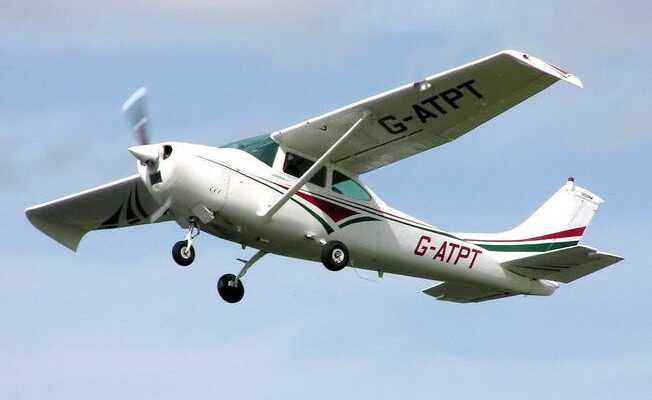A flight by Federal Councilor Alain Berset in France triggered the deployment of an interceptor. The sky is full of invisible borders that have challenged many pilots.
Federal Councilor Berset is said to have entered a French restricted area in a Cessna 182.
“Above the clouds, freedom must be limitless,” once sang Reinhard Mey, who is a pilot himself. But that’s not the case: there are restricted areas invisible in the sky, special airspaces that you can’t cross without permission, or even military training areas that private pilots, for example, are not allowed to fly into.
What exactly happened to Federal Councilor Berset in France, whether the jets rose because of him or were already in the air, is not entirely clear. It is clear that France does not lightly send out a Rafale fighter jet to see which plane is flying somewhere illegally. First of all, an attempt is made to reach the pilot by radio.
If that doesn’t work, one of the usually two fighter jets closes up to the aircraft and sits next to the machine. Then the civilian pilot is told to follow the military planes by wagging the wing. If the fighter plane also demonstratively extends its landing gear, it is clear that you have to land at the next airfield.
Careful planning comes first
In order to prevent something like this, every responsible pilot creates a detailed flight plan. To do this, he catches up on the probable weather on the route via computer or telephone advice, looks at the planned flight route on his paper aeronautical map or on a tablet computer and thinks about how and at what altitude he can best reach his destination.
Because simply flying straight to your destination only works in theory: Airports, military airfields, obstacles such as nuclear power plants and the like on the direct route mean that instead of a straight line, as some laypeople imagine, it is more of a zigzag course with different ones flight altitudes to the destination. Flying around areas where bad weather prevails is often an additional factor.
Sometimes, however, it is known well in advance that a special area is closed to visual flight, usually up to an altitude of 10,000 feet, which is about 3,000 meters. In Switzerland, this is the case every year at the WEF in Davos. Federal professional and private pilots know this and are not surprised by it. Foreign pilots who unsuspectingly want to fly in transit over the Swiss Alps, on the other hand, are unpleasantly surprised when a Swiss F/A-18 suddenly flies next to them and the pilot signals.
Restricted areas are clearly marked in France
In France, it is also no fun when someone flies unauthorized into military airspace or – even worse – low over nuclear power plants. These military airspaces or restricted areas at nuclear power plants are clearly marked as restricted areas on the paper aeronautical charts or, alternatively, on a tablet, which pilots must carry with them in the cockpit. They are also clearly highlighted in the aviation GPS. In addition to red or blue hatching on the so-called Icao map, which shows the size of the restricted area, there is usually an indication of the altitude.
At the French nuclear power plant in Fessenheim, just 30 kilometers from Basel on the Rhine, it says “3300 – Ground”. A pilot then knows that you have to be at least 3300 feet – about 1100 meters – high and under no circumstances may you fly lower over the nuclear power plant. Otherwise an alarm will be triggered because the authorities fear a possible terrorist threat from an aircraft. In the worst case, two military jets usually take off from the nearest airfield and see what’s going on.
If, like Federal Councilor Berset, you are caught allegedly flying into a restricted military area without permission, you will probably be informed of the responsible body, such as the European Aviation Safety Agency (EASA) or the Federal Office of Civil Aviation. They may check whether the pilot has made correct flight and weather planning. In addition, the pilot is asked to comment. It is also investigated whether he may have committed an offense through negligence or even gross negligence, such as flying into closed airspace or violating a control zone at airports.

Alain Berset, Federal Councilor (SP), photographed in the Federal Department of Home Affairs in Bern.
Good maps are a must
Federal Councilor Berset was apparently traveling in France in a single-engine Cessna 182 according to visual flight rules, and this probably without radio communication. The four-seater propeller plane with 230 hp is something like the VW Passat in aviation. For a flight, the pilot must carry an up-to-date paper aeronautical chart for the area flown. Alternatively, a portable or permanently installed aviation GPS in the cockpit is sufficient. This also shows the so-called airspace structure and makes navigating much easier than just using a map and clock.
However, since many airspaces change in size or altitude from year to year, an aviation GPS must also be constantly updated in order not to lull the pilot into a false sense of security. There are also so-called Notices for Airmen or, more recently, Notices for Air Missions, Notam for short. It contains all short-term changes that affect airfields or airspace for visual pilots. An aviation event took place at the Stanserhorn in central Switzerland around the beginning of July. A notice was published beforehand that the airspace around the Stanserhorn would be closed to other air traffic for a defined period of time on this day.
An airspace violation can result in a warning or fine, but in the worst case even the pilot’s license is gone. This is what happened to a neglectful German private pilot a few years ago, for example. Coming from the west, he wanted to land his Cessna at the small Landshut airfield northeast of Munich. Because he probably got quite lost, he headed instead for Munich International Airport, about 20 kilometers from Landshut, with its two huge runways.
He landed there without being on the appropriate radio frequency and against the intended landing direction at the time. All approaching airliners were put on hold for a quarter of an hour because nobody in the airport tower knew what kind of plane was approaching from the wrong direction and without radio contact. This is best compared to a wrong-way driver on the Autobahn. The responsible air authority in southern Bavaria withdrew the license from the hobby pilot, who had not been a pilot for very long, after this serious violation.
Most of the time, however, it is easier. If no one was endangered and the pilot was only slightly negligent, you may get away with a warning. Whether Federal Councilor Berset has to pay for the use of the Rafale now also depends on how the French authorities assess the incident.
